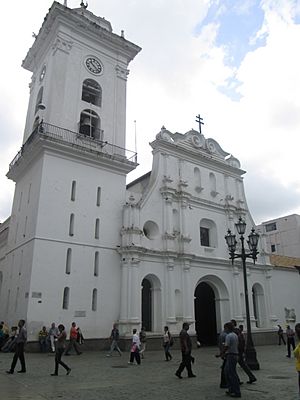Caracas Cathedral facts for kids
Quick facts for kids Caracas Cathedral |
|
|---|---|
| Catedral Metropolitana de Santa Ana | |

Caracas Cathedral
|
|
| 10°30′22″N 66°54′50″W / 10.5062°N 66.9140°W | |
| Location | Caracas |
| Country | Venezuela |
| Denomination | Roman Catholic |
| History | |
| Status | Cathedral |
| Founded | 1666 |
| Dedication | Saint Anne |
| Architecture | |
| Functional status | Active |
| Style | Romanesque |
The Caracas Cathedral, also known as the Metropolitan Cathedral of Saint Anne, is a very important Roman Catholic church in Caracas, Venezuela. It is the main church for the archdiocese of Caracas. You can find it right on the Plaza Bolívar, a central square in the city. Inside one of its chapels, the Chapel of the Holy Trinity, you can find the burial places of Simón Bolívar's parents and his wife. There is also a square called Nuestra Senora de Venezuela y Santa Ana nearby, which faces the cathedral.
Contents
A Look Back: The Cathedral's Story
The first church on this spot was a small chapel built in the mid-1600s. It had mud walls and was dedicated to Saint James. Sadly, an earthquake in 1641 destroyed it.
Building and Rebuilding
The construction of the current cathedral began in 1666. Juan de Medina led this project. A bell tower was added, and the church was finished in 1674. The front part of the building, called the façade, was completed in 1771 by Francisco Andrés de Meneses.
Earthquakes and Changes
The cathedral faced damage from more earthquakes in 1766 and 1812. On March 26, 1812, a powerful earthquake hit Caracas. Many people were inside the church when it crumbled. Some people died, and many were hurt. After this earthquake, one of the cathedral's towers was damaged and made smaller.
In 1866, a new front section was built on the façade. The cathedral has special underground rooms called crypt chambers. The most famous one holds the remains of Simón Bolívar's parents and his young wife. Simón Bolívar's own remains were here from 1842 until 1876. They were then moved to the Panteón Nacional, a national monument a few blocks away. The cathedral also had important restoration work done in 1932 and again in the 1960s.
Inside the Cathedral: Architecture and Art
The Caracas Cathedral is built from stone and has a tile roof. It is about 270 feet long and 81 feet wide. Inside, 24 simple pillars support the structure. In 1812, the brick bell tower held the only public clock in the city.
Design and Layout
The cathedral's design is called Romanesque. It has five long sections called naves. There is a large central nave and two smaller ones on each side. This makes the inside look very wide. The central nave is separated from the side ones by 32 octagonal columns. These columns have special tops called composite capitals and support round arches. The columns were updated in the late 1800s.
Altars and Artworks
The main altar and its decorative screen, called an altarpiece, are located at the end of the central nave. The altars are covered in gold, and the side chapels are very detailed. A special altar for the Bolívar family is located on the right side. It features a modern sculpture of Simón Bolívar, known as "El Libertador" (The Liberator). There is also a colorful altar at the back of the cathedral.
The cathedral's organ was built in 1711 by a French immigrant named Claudio Febres. One of the baptismal fonts, which was used to baptize Simón Bolívar, is now located at his childhood home. The cathedral also has many important religious artworks. These include The Resurrection by Peter Paul Rubens, the Presentation of the Virgin by Bartolomé Esteban Murillo, and The Last Supper, an unfinished painting by the Venezuelan artist Arturo Michelena.
Important People Connected to the Cathedral
Many notable people have been part of the cathedral's history. Manuel de Sosa Betancourt was an important church leader called an archdeacon. Carlos Herrera Mesones (1705–1761) was a canon and the cathedral's treasurer. Ambrosio de Carreno (1721–around 1801) was the music director from 1750 to 1774.
Before he became a priest in 1789, Jose de la Luz Urbano (1755–1810) was the cathedral's organist. José Cayetano Carreño (1774–1836) was the cathedral's organist from the age of 15 until he passed away. In 1796, José Ángel Lamas became the first bassoon player in the cathedral's orchestra. His most famous piece, Popule Meus, was first performed in the cathedral in 1801. Pedro Palacios y Sojo (1739–1799), who was a priest and composer, became a church leader at the cathedral in 1798.
See also
 In Spanish: Catedral metropolitana de Santa Ana (Caracas) para niños
In Spanish: Catedral metropolitana de Santa Ana (Caracas) para niños
- Catholic Church in Venezuela
- List of cathedrals in Venezuela



